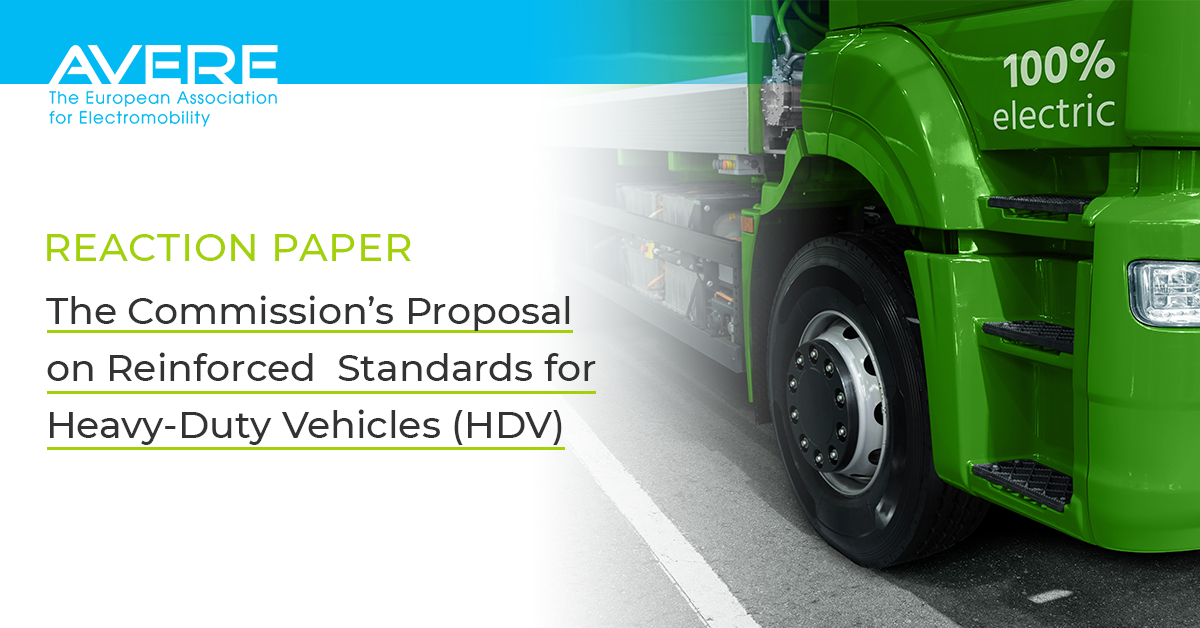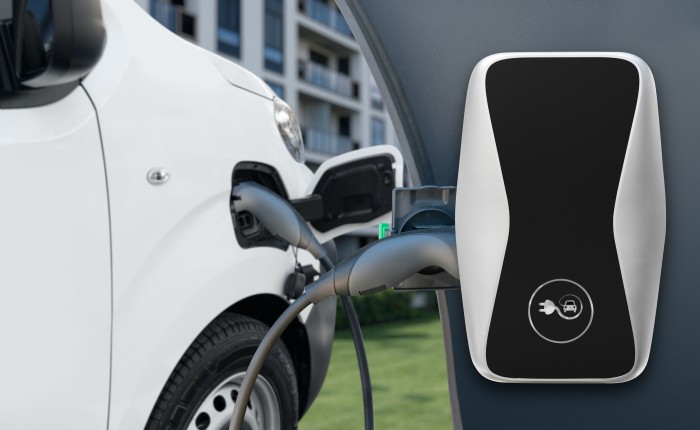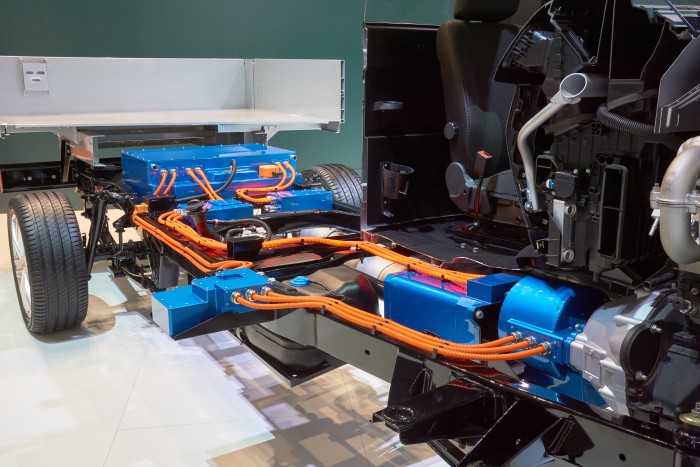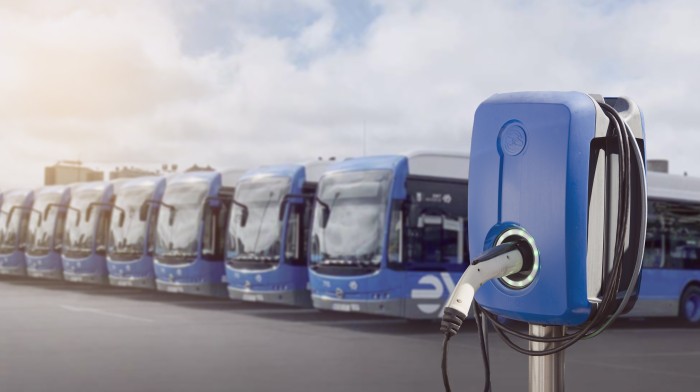
AVERE welcomes the European Commission's proposal to strengthen the existing legislative framework setting CO2 standards for Heavy-Duty Vehicles.
Since lorries, buses and coaches are responsible for about a quarter of CO2 emissions from road transport in the EU, their full decarbonisation is a precondition for reaching climate neutrality in 2050. In an intensifying global race for Net-Zero technology leadership, the revision is also necessary in order to safeguard European jobs and competitiveness both in the production of HDVs, as well as the supporting supply chain and broader ecosystem.
REACTION PAPER
to the Commission’s proposal on reinforced CO2 standards for Heavy-Duty Vehicles (HDV)

AVERE welcomes the European Commission's proposal to strengthen the existing legislative framework setting CO2 standards for Heavy-Duty Vehicles. Since lorries, buses and coaches are responsible for about a quarter of CO2 emissions from road transport in the EU, their full decarbonisation is a precondition for reaching climate neutrality in 2050. In an intensifying global race for Net-Zero technology leadership, the revision is also necessary in order to safeguard European jobs and competitiveness both in the production of HDVs, as well as the supporting supply chain and broader ecosystem.
The proposed revision takes important steps in the right direction by extending the scope of the standards beyond the largest trucks, setting a more ambitious target trajectory up to 2040, and establishing a dedicated phase-out date for urban buses in 2030. However, the lack of a clear end date for polluting vehicles and a variety of loopholes and exemptions in the text may undermine its overall ambition and prevent it from serving its purpose of bringing EU heavy transport in line with the bloc’s legally binding climate targets.
A more ambitious trajectory is both necessary and feasible. All key enablers for a rapid transition are in place:
- Fully electric heavy duty vehicles are available to the market, and are rapidly closing in on conventional diesel trucks in terms of their total cost of ownership (TCO), supported by EU instruments such as ETS II and the Eurovignette
- Battery ranges are increasing, allowing for the deployment of electric heavy duty vehicles without the need to significantly modify established operational patterns
- The proposed Alternative Fuels Infrastructure Regulation (AFIR) will guarantee the necessary initial coverage of dedicated HDV charging infrastructure along key EU roads.
AVERE therefore calls building further on the Commission’s initial proposal:
1. Conclude the negotiations by the end of 2023
Manufacturers of ZE-HDVs need visibility on decarbonisation targets (both short-term and long-term) to develop their ZEHDVs. If this proposal would be finalised after the next European Parliament election, its delayed adoption would result in uncertainty for manufacturers. This is especially the case for the -45% target for 2030, which can beachieved if manufacturers get a clear signal by policymakers in 2023.
2. Build on the proposed extension of scope to cover all EU Heavy Duty Vehicles
The EU’s aim to become carbon neutral in 2050 requires the full decarbonisation of road transport, and thus relevant regulatory files have to cover all vehicles on EU roads. Against this background, AVERE strongly welcomes the extension of the scope of current standards to also cover smaller trucks, buses, coaches, and large trailers.However, too many exemptions currently apply - notably for vocational vehicles like garbage trucks or concrete mixers, for which fully electrified versions are already available on the market. There are no inherent characteristics preventing the use of zero-emissions solutions for these use cases. In cases where there is currently no possibility of VECTO certification, legislators should thus consider a ZEV mandate. As a rule, exemptions should only be granted for individual use cases where zero-emissions solutions are demonstrably not available or feasible, and they should be regularly reviewed.

3. Set a 100% emissions reduction target in 2040
The Commission’s proposed trajectory of a 45% reduction target in 2030, followed by a 65% target in 2035 and a 90% one in 2040, undoubtedly constitutes a significant improvement over currently applicable standards. However, it regrettably stops short of setting a clear 100% target, and thus an end-date for non-zero emission vehicles on European roads. According to the Commission’s own impact assessment, such an end date would not only be feasible, but also reap economic and environmental benefits in the long run.
A de facto phase-out date for polluting trucks would also be clear signal for industry and the surrounding ecosystem, focussing efforts in areas such as reskilling and charging infrastructure buildout, whilst ensuring the EU will not fall behind third countries - the 2036 ZEV truck mandate set by California is only one example for a global decarbonisation race in which the EU cannot afford to be left behind.
In fact, even 2040 may be a late date, as newly sold trucks today will remain on EU roads for many years to come. As of 2022, the average truck in Greece was 21.4 years old, with trucks in Italy having been in service for an average 18.5 years, Estonia boasting an average 17.6 years, and Belgian trucks being 16 years old on average, indicating many trucks sold in 2039 will still be circulating long after 2050.
4. Set interim targets in line with announced industry ambition
Similarly, the proposed interim target should be strengthened further. Given the lifespan of EU trucks outlined above, the 90% target currently planned for 2040 could be brought forward to 2035, decarbonising in a timely manner the majority of EU trucks while giving niche segments additional time to adapt.
In the shorter term, more ambitious targets are necessary as well: a 65% target in 2030 would ensure compliance with the EU’s own legally binding climate law and only slightly exceed what truckmakers themselves have already announced voluntarily[1]. Furthermore, a 30% interim target in 2028 has been shown to be feasible in previous studies[2] and could significantly accelerate the scaling up of the EU’s ZE-HDV market, yielding economic benefits for operators all across Europe and weaning Europe off its dependency on oil imports - for example from Russia - more quickly.

5. Close technical loopholes to avoid undermining the ambition of the regulation
Beyond the scope for a further increase in ambition, the proposal also fails to appropriately remedy a number of technical loopholes that may further undermine the ambition of the proposal.
Notably, while AVERE supports the decision to phase out the ZLEV incentive scheme by 2030, the current target of 2% as of 2025 is set significantly too low given the required major ramp-up of ZEV sales - especially as it includes “low-emissions'' solutions, which still produce tailpipe emissions and therefore cannot make a meaningful contribution to climate neutrality in the medium and long term. The mechanism should therefore focus exclusively on ZEVs to encourage their initial uptake, setting a higher benchmark of 10-15% of sales, before being entirely phased out as of 2028.
Furthermore, credits under the credit/debt system should, like debts, be cleared after five years. OEMs should not be able to trade off early efforts for a lack of ambition throughout coming years or even decades. Lastly, exemptions for small volume manufacturers should be removed as well, as there is no objective justification to exempt them - in fact, most small volume manufacturers and new market entrants are already fully committed to zero-emissions drivetrains. Neither climate nor citizens’ health differentiate between trucks from large and small volume OEMs.
6. Clarify and significantly narrow the scope of exemptions for urban buses
AVERE strongly supports the 100% emissions reduction target set for urban buses in 2030, as they play a key role in fighting air pollution as the most common environmental cause of death in Europe at approximately 238,000 premature deaths in 2020. The electrification of urban buses is already a reality in many European cities due to their operational patterns offering themselves to electrification, ample opportunities to recharge either at the depot or en route, and a broad variety of models available to the market.
However, the scope for exemptions in individual member states is currently too broad and ill-defined, allowing for the use of polluting vehicles inter alia due to “socio-economic cost-benefit in view of specific territorial morphology or meteorological circumstances”. Europe’s lead market for electromobility, Norway, clearly demonstrates that zero-emission vehicles can operate under nearly any geographical and/or meteorological circumstances. The scope for such exemptions should thus be significantly clarified and limited.

7. Clarify key definitions
Clear definitions are another key determinant of how stringent the proposed regulation will turn out in practice. Two improvements are particularly urgent:firstly, the revised definition of “zero-emission vehicle” is too broad. It would set a dangerous precedent to classify vehicles that emit 5g CO2/tkm as “zero emission”, which may even allow for some extent of fossil fuel blending. The co-legislators should go back to the 1 gCO2/kWh definition, which would allow for spark-ignited internal combustion trucks which are powered by hydrogen.
Secondly, the definition of “long haul” heavy duty vehicles - currently only implicitly set in the annex - will shape the market for years to come as battery ranges grow, and should thus be set more ambitiously than 350 km range. Due to the rules on mandatory rest time for truck drivers every 400 km, the definition of a long-range truck should be above that threshold.
Assuming that the distance between stops is 80%, the proposed long-range definition should be 500 km.
8. Adapt the proposed review date to the timeline of negotiations
The 2028 review could serve as a basis to strengthen the CO2 standards even more. However, if the co-legislators agree on the law only in 2025, a 2028 review comes too early. Therefore, the review should take place only 5 years after the publication in the Official Journal.
9. Maintain dissuasive penalties and avoid including loopholes for e-fuels
In recent weeks, there have been calls to undermine the Commission’s proposal further, severely sabotaging the EU’s pathway to-net zero. Two main pathways stand out:
Firstly, there have been repeated calls for including a backdoor for zero- or low carbon fuels. As outlined in previous AVERE positioning, those fuels are expensive, sparse, energy-inefficient, and more urgently needed in other sectors such as shipping and aviation. Their use is difficult to trace in reality, and they do nothing to tackle air pollution either. Attempts to insert any accounting mechanism or loophole for low-carbon fuels, biofuels or synthetic fuels should thus be strongly opposed.
Secondly, it has been demanded to remove or condition penalties for OEMs that fail to meet their obligations, for example in case there is a lack of charging infrastructure or other enabling conditions. Besides the difficulty in determining which conditions would qualify as “sufficient”, this would effectively render what was a strong regulation not much more than an aspirational recommendation. It would keep the EU trapped in a “chicken and egg” dilemma, with truckmakers not ramping up production due to a perceived lack of enabling conditions, and the surrounding ecosystem not investing in raw materials infrastructure and supply chain due to a lack of vehicles. It is therefore important to oppose any attempt to water down penalty provisions.
AVERE stands ready to engage with policy makers and further build on the first step in the right direction proposed by the Commission. Only through decisive action can we safeguard our climate and citizens’ health, while making Europe a global leader in ZEV technology.
[1] https://theicct.org/wp-content/uploads/2022/03/hdv-co2standards-recs-wp-mar22.pdf
[2] https://www.transportenvironment.org/discover/eu-truck-targets-too-weak-to-incentivise-the-production-of-enough-zero-emission-vehicles
